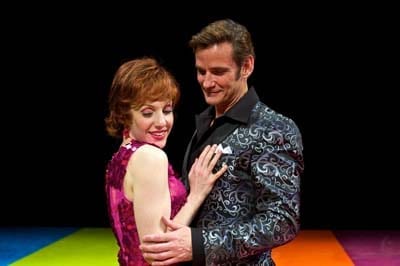SALT LAKE CITY — The summer is coming and we are in for some fireworks. The pop, sizzle, and sparkle will awe and inspire you. But the show isn’t in the sky this time; it’s on the stage of Pioneer Theater Company’s Sweet Charity, where an endearing dance hall girl looks for love. Although Sweet Charity is a show with some weaknesses in the plot, the set, the costumes, and the explosive dancing are the stars in this spectacle directed by Karen Azenberg.
Lighting the initial blast was George Maxwell, who created a bold and beautiful set. Nothing was understated: tiger-striped wallpaper, flower-shaped furniture, and large signs announcing, “first kiss” and “proposal.” Maxwell’s elevator for Charity and Oscar was inventive, with the façade rising up as the actors remained trapped. The lighting (designed by Michael Gilliam) was a slick side-kick to the set, enhancing, for example, the feeling of claustrophobia and fear. I’m a fan of Maxwell’s use of scale, especially, like when Oscar and Charity are dwarfed by the big stage with the cityscape behind them; it emphasized the exaggerated quality of the show.
Lately, I’m realizing just how connected the set and the costumes are in theatre. In Pioneer’s production, the attire was just as big and bright as the stage. There were sheath dresses, leisure suits, bell-bottoms, tie-dye, sequins, every color imaginable, and a huge variety of wigs. The most striking image was in the Pompeii club, where the ensemble wore black and white, mop-top wigs, and all kinds of patterned leggings. It was a stunning image, and one of my favorite scenes. Costume designer Patrick Holt is a talented artist.
Wrapping up the list of whiz-bang elements is Azenberg’s choreography. From the very first scene, Charity Hope Valentine (Nancy Lemenager) set the physical tone of the show, as she threw herself about, around, up, and down, expressing her enthusiastic affection toward her beau. Each dance number in the show matches or surpasses Lemeanger’s whole-hearted performance. Lemenager’s big moment, for me, was in Vittorio’s apartment; Azenberg pulled out all the stops and gave Lemenager an encyclopedia of moves, which were executed perfectly. What a vivid piece of art!

Standing: Gerry McIntyre as Big Daddy Brubeck and Lenny Daniel. Seated: Carly Blake Sebouhian and Courtney Iventosch. Photo by Alexander Weisman.
Similar to a firework show, the visual elements of Sweet Charity were more impressive than the sound. Standouts in the vocal department were harder to find, as many numbers skimmed by uneventfully. The musical performances worth mentioning belonged to the women of the Fandango Ballroom, in “Big Spender,” and specifically the fantastic Natalie Hill (as Helene) and Angie Schworer (as Nickie), in “Get Up, Get Out” and “Baby, Dream Your Dream.” Those women were powerful and convincing when performing Cy Coleman‘s music and Dorothy Fields‘s lyrics. The show was stronger when they were onstage. As far as men, Sean McDermott was divine as Vittorio, singing “Too Many Tomorrows” with such a warm and full tone. The ensemble was less vocally impressive, and I was most underwhelmed by the cast’s breathy “Rhythm of Life.” The ensemble’s acting, though, was an asset to the show as they transformed to each new environment and style.

Left to right: Nancy Lemenager as Charity, Angie Schworer as Nickie, and Natalie Hill as Helene. Photo by Alexander Weisman.
Sweet Charity has an array of settings and situations, which creates a lot of interest, but also ultimately leaves the script (by Neil Simon) very weak. Many of the scenes had no real relevance to the plot; “Rhythm of Life” may have been fun to watch, but what was its purpose? The second act lost all momentum and any promise of progression in the characters. Charity ends the show as the same person who began it, along with every other character. It’s possible that Charity’s departure from her job was meant to be a big moment, but I didn’t get the sense that she’d be losing much by quitting. The construction of the plot—and its fizzled conclusion—made it clear to me why Sweet Charity isn’t produced more often.
I have never returned home on the 4th of July fretting about the cohesiveness of the pyrotechnics. Pioneer has a wonderfully grand and colorful production with Sweet Charity. With talent in design and dance, there is quite a lot to enjoy about this production of Sweet Charity.







